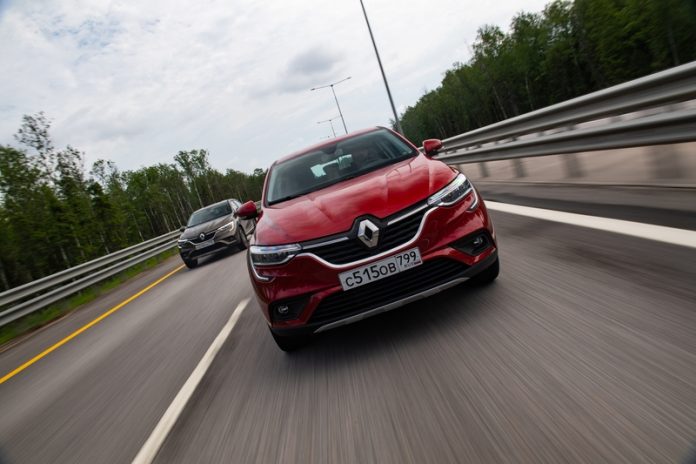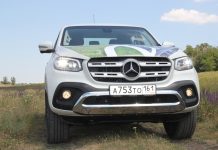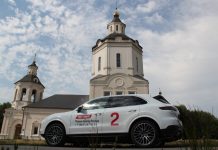Unusual shapes are considered an unaffordable luxury in the budget segment. After all, those who know how to count their money are more likely to choose a practical car than a designer one. However, Renault’s Russian representative office decided to take a risk and launch a bright and attractive car called the Arkana. A month ago, the first batch of 100 of these crossovers was sold in just three hours. The editors of Yuzhny Avtomobil went to St. Petersburg to test drive the new model to find out how good or bad the new Arkana is.

As you remember, in the early 90s, French cars attracted buyers with their unusual design – avant-garde, bold, and cutting-edge. But in the early 2000s, after the French acquired the Romanian brand Dacia, the extravagant Laguna, Megane, Clio, and other purely French models were replaced by the angular Logan, Sandero, and Duster. But still, our customers want a car that is not only practical but also impressive. And yet, it also needs to be affordable. Renault’s Russian representative office has long understood the sentiments of domestic buyers and rolled out the Arkana coupe-crossover, which appeals not only for its appearance and practicality, but also for its price.

Renault’s Russian office has constantly fueled interest in the model, starting with the concept’s premiere at the 2018 Moscow Motor Show. At the time of its Russian premiere in May 2019, pricing for the top-of-the-line Arkana version was announced. The price of the exclusive and most expensive version was 1,499,000 rubles. The first batch of 100 cars sold out online in three hours. So, we’re in St. Petersburg for the first drive-by presentation of the Arkana. Our cars are from the very first, pre-production batch, which means we have the opportunity to tell you about the car before it hits the streets of Russian cities.

Looks more expensive than it costs
Journalists were given the most expensive versions of the Arkana crossover for a test drive. Our cars feature a 1.3-liter turbo engine and all-wheel drive in the exclusive Edition One trim. The sloping lines of the crossover coupe attract the attention of passersby, owners of domestic passenger cars, and even those driving premium cars. From the first meters of our drive along the roads of the cultural capital, people stare at us, or rather, at the Arkan, as if we were a museum exhibit. A stylish car with a sloping roof, striking LED headlights, and a raised rear definitely contributes to the positive perception of the new model. Our Arkana is perceived by others as something premium and luxurious. At one intersection, a man from a neighboring car asks about the Arkana’s price and is surprised by the 1.5 million ruble price tag.
What’s surprising here is that, despite the maximum price tag, Renault engineers managed to create a harmonious and stylish car that doesn’t feel cheap, but looks expensive and luxurious. Even the base version of the Arkana will attract attention thanks to its unusual form factor.

The only thing that somewhat dissonates with the striking appearance is the Arkana’s interior. Everything inside is rather modest, and the materials feel rough to the touch. The upper part of the dashboard, where the air vents are located, is made of lacquered plastic, which does show fingerprints. The instrument panel features modest tachometer and speedometer dials with white backlighting, red needles, and a monochrome trip computer display.
The multimedia system screen is located in the center. It’s not a Retina display like the ones on modern iPhones, but it’s still quite appealing. The radio’s graphics are simple, yet informative and easy to understand.
Another innovation recently promoted by the Nissan-Renault alliance is a multimedia system with Yandex.Auto support and the Alice voice assistant. This interactive assistant can start the car, find the desired radio station, and set a comfortable temperature in the cabin. You can communicate with the assistant using voice commands.
The radio supports Apple CarPlay and Android Auto, but you can also install the Yandex app on your smartphone and use its navigation. The organizers equipped our cars with smartphones running the latest version of Yandex navigation, which isn’t yet available to regular users.

Yandex.Navigator broadcasts the route directly to the car’s multimedia system display via the smartphone. While this solution is convenient, we occasionally lost cellular service along the route, causing the navigation to become noticeably slow. We also had to periodically unplug the phone’s cable from the USB port to get everything working properly.
This minor glitch will likely be fixed in production vehicles after Yandex.Auto has been tested with journalists. The car also has standard navigation with TomTom software, which is generally quite good. If you’re willing to pay extra for the virtual assistant Alice and Yandex service, the decision is yours.

I’d especially like to commend the car’s four cameras—front, rear, and two side ones. You’ll agree, not every crossover priced at 1.5 million rubles can boast such an arsenal. I was also pleased with the presence of parking sensors and blind spot monitoring. The driving position is comfortable, and the steering wheel is adjustable for height and reach. The seats in our cars are upholstered in eco-leather and offer good lateral support. Versions with a combination of interiors are also available. The driver’s seat is height-adjustable in the base model, and lumbar support is included in the top-of-the-line trim levels.

But all seat adjustments are manual, so you don’t forget that you’re behind the wheel of a Renault, not a more expensive premium car. The steering wheel is covered in leather, and the window regulator unit is now located on the driver’s door armrest, not between the seats, as in the Duster. The climate control unit has an original design, displaying the selected temperature inside the rotary element. Overall, the interior leaves a quite pleasant impression, despite the rough plastic and “piano lacquer” finish, but at least these aren’t plastic inserts imitating wood, and at least thanks for that.
How it drives
During the test drive, journalists had the opportunity to evaluate only cars with a 1.3 turbo engine. This engine was developed by Daimler and is installed in the Mercedes-Benz A-Class, where it produces 163 horsepower and is paired with a seven-speed automatic transmission that shifts gears in a split second.
Since Renault isn’t a premium brand, the Arkana produces 150 horsepower and is paired with a continuously variable transmission. Its 250 Newton-meters of torque pull the car well even at speeds of 80-120 km/h, allowing you to pass two trucks in a row in one go. If you want, you can drive quite fast in the new Renault crossover; the top speed is 191 km/h. Acceleration from 0 to 100 km/h takes 10.5 seconds. It’s not a race car, but quite capable. However, all of this applies to the car with a 1.3-liter engine.

The base model will have a very weak H4M engine with a displacement of 1.6 liters and 115 horsepower, the same one found in the Lada XRay. No cars with this engine were tested by journalists, but the Arkana’s claimed acceleration from 0 to 100 km/h takes 15.2 seconds. That’s a truly low-end option. Meanwhile, the difference between the entry-level Arkana versions with a 1.3 and 1.6 engine, according to the stated price list, is 90,000 rubles. The turbocharged engine makes the crossover a spirited performer, but the only question remains how long this engine will last and whether the claimed horsepower will run out after 100,000-150,000 kilometers.

Off-Road
The new Arkana’s ground clearance is 205 millimeters, just five millimeters less than the Duster’s, so the crossover coupe feels right at home off-road. To begin, the organizers prepared a test area for journalists and the Renault Arkana, where they could test the car on special metal ramps and see how it handles on a steep incline, a side slope, or when diagonally suspended. With the exception of the steep climb, the Arkana would have easily overcome the remaining obstacles, including diagonal overhangs, even with front-wheel drive.

For real off-roading, we had to head to the forests of the Leningrad region. The Duster’s roots become apparent as soon as the Arkana leaves the asphalt. On fine gravel, the car easily covers over 100 kilometers. The crossover coupe’s suspension effortlessly handles small potholes and uneven surfaces, and road imperfections aren’t transmitted through the steering wheel. You can’t intentionally try to skid; the ESP system firmly suppresses any such attempts. The Arkana will also navigate rough terrain, but remember that it’s not a Duster, so there’s a risk of ripping off the bumper. We also managed to cross some relatively shallow fords during our trip through the forest.

Prices
For now, the Renault Arkana will be sold only in the Russian market; it will be released in the CIS countries a little later. Renault is not yet talking about deliveries to other countries. For now, the Arkana is a car made in Russia and for Russia. Currently, the Renault Arkana has virtually no competitors, as other brands do not offer crossover coupes in the non-premium segment. As for the palette of the new Arkana, red is the only bright color offered to buyers. There is also white, if you can call it bright. The other colors are more subdued: black, gray, dark gray, gray-green, and gray-brown. Renault states that these are the colors for which they received the most requests from Russian buyers during demand research. The base model of the new Renault Arkana crossover will cost 999,000 rubles in Russia. In total, the car is available in four trim levels: Live, Drive, Style and Edition One.

Live










